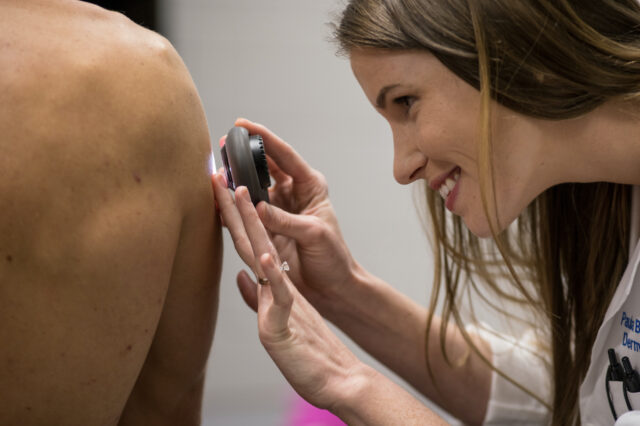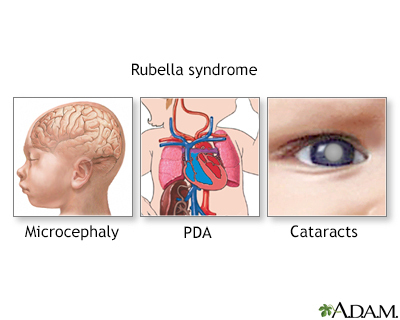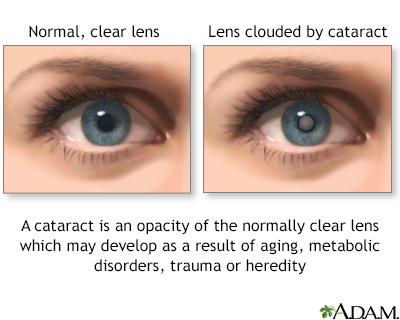Congenital cataract

Definition
A congenital cataract is a clouding of the lens of the eye that is present at birth. The lens of the eye is normally clear. It focuses light that comes into the eye onto the retina.
Alternative Names
Cataract - congenital
Causes
Unlike most cataracts, which occur with aging, congenital cataracts are present at birth.
Congenital cataracts are rare. In most people, no cause can be found.
Congenital cataracts often occur as part of the following birth defects:
- Chondrodysplasia syndrome
- Congenital rubella
- Conradi-Hünermann syndrome
- Down syndrome (trisomy 21)
- Ectodermal dysplasia syndrome
- Familial congenital cataracts
- Galactosemia
- Hallermann-Streiff syndrome
- Lowe syndrome
- Marinesco-Sjögren syndrome
- Pierre-Robin syndrome
- Trisomy 13
Symptoms
Congenital cataracts most often look different than other forms of cataract.
Symptoms may include:
- An infant does not seem to be visually aware of the world around them (if cataracts are in both eyes)
- Gray or white cloudiness of the pupil (which is normally black)
- The "red eye" glow of the pupil is missing in photos, or is different between the 2 eyes
- Unusual rapid eye movements (nystagmus)
Exams and Tests
To diagnose congenital cataract, the infant should have a complete eye exam by an ophthalmologist. The infant may also need to be examined by a pediatrician who is experienced in treating inherited disorders. Blood tests or x-rays may also be needed.
Treatment
If congenital cataracts are mild and do not affect vision, they may not need to be treated, especially if they are in both eyes.
Moderate to severe cataracts that affect vision, or a cataract that is in only 1 eye, will need to be treated with cataract removal surgery. In most (noncongenital) cataract surgeries, an artificial intraocular lens (IOL) is inserted into the eye. The use of IOLs in infants is controversial. Without an IOL, the infant will need to wear a contact lens.
Patching to force the child to use the weaker eye is often needed to prevent amblyopia.
The infant may also need to be treated for the inherited disorder that is causing the cataracts.
Outlook (Prognosis)
Removing a congenital cataract is usually a safe, effective procedure. The child will need follow-up for vision rehabilitation. Most infants have some level of "lazy eye" (amblyopia) before the surgery and will need to use patching.
Possible Complications
With cataract surgery there is a very slight risk of:
- Bleeding
- Infection
- Inflammation
Infants who have surgery for congenital cataracts are likely to develop another type of cataract, which may need further surgery or laser treatment.
Many of the diseases that are associated with congenital cataract can also affect other organs.
When to Contact a Medical Professional
Call for an urgent appointment with your baby's health care provider if:
- You notice that the pupil of one or both eyes appears white or cloudy.
- The child seems to ignore part of their visual world.
Prevention
If you have a family history of inheritable disorders that could cause congenital cataracts, consider seeking genetic counseling.
Gallery




References
Cioffi GA, Liebmann JM. Diseases of the visual system. In: Goldman L, Schafer AI, eds. Goldman-Cecil Medicine. 26th ed. Philadelphia, PA: Elsevier; 2020:chap 395.
Lambert SR, Cotsonis G, DuBois L, et al; Infant Aphakia Treatment Study Group. Long-term effect of intraocular lens vs contact lens correction on visual acuity after cataract surgery during infancy: a randomized clinical trial. JAMA Ophthalmol. 2020;138(4):365-372. PMID: 32077909 pubmed.ncbi.nlm.nih.gov/32077909/.
Lambert SR, Wilson ME Jr, Plager DA, Lloyd IC. Update on pediatric cataracts. AAPOS Webinar. May 12, 2017. www.aao.org/annual-meeting-video/update-on-pediatric-cataracts. Accessed November 16, 2021.
Örge FH. Examination and common problems in the neonatal eye. In: Martin RJ, Fanaroff AA, Walsh MC, eds. Fanaroff and Martin's Neonatal-Perinatal Medicine. 11th ed. Philadelphia, PA: Elsevier; 2020:chap 95.
Wevill M. Epidemiology, pathophysiology, causes, morphology, and visual effects of cataract. In: Yanoff M, Duker JS, eds. Ophthalmology. 5th ed. Philadelphia, PA: Elsevier; 2019:chap 5.3.
